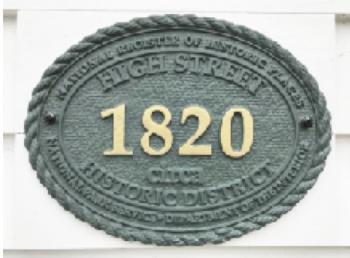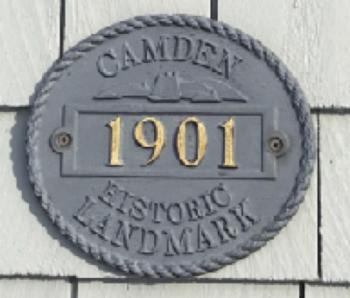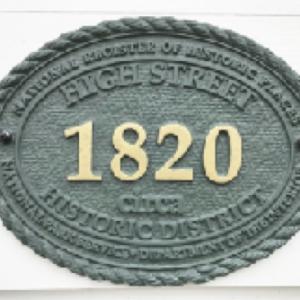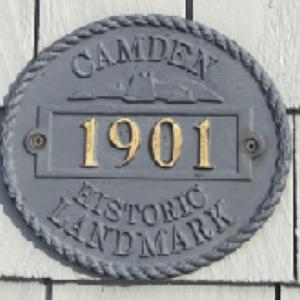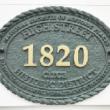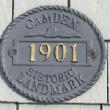About those historic house plaques in Camden and Rockport
If you’ve ever noticed the small oval plaques placed on the front of many homes in Camden and Rockport and wondered what they signify and how they happened to be on some houses and not others, here is a brief explanation.
If you look closely, there are actually two different markers currently found on local homes, and they represent two different programs.
One marker represents a national program which recognizes that a building is historically significant and worthy to be placed on the National Register of Historic Places. This Register is a program of the U. S. Park Service, a branch of the Department of the Interior.
The other marker represents a local program active in the 1980s called the Camden-Rockport Historic Landmarks Commission which recognized local buildings of historic significance. The Landmarks Commission pre-dated much of the Camden involvement in the National Register Program.
At the time when the Landmarks Commission was established in 1980, only four structures in Camden had previously been placed on the National Historic Register: the Camden Yacht Club; Norumbega; the Conway House; and Curtis Island Light.
The Yacht Club was placed on the Register in 1980; Norumbega in 1974; The Conway House in 1969; and the Curtis Island Light in 1973.
The Landmarks Commission first met in July 1980. It was conceived by the historic subcommittee of the Camden Improvement Committee (CIC) which was a branch of the Rockport-Camden-Lincolnville Chamber of Commerce. The Landmarks Commission was convened by Col. Wendell Johnson who represented both the CIC and the Camden-Rockport Historical Society.
Shortly after the Camden Landmarks Commission held its first meeting, the Camden-Rockport Historical Society suggested that the Rockport Conservation Committee establish a similar counterpart for Rockport, and together the two newly formed groups became the Camden-Rockport Landmarks Commission. Although each group held separate meetings, they shared many materials and kept each other apprised of their activities.
The initial project of the Camden Committee of the Landmarks Commission was to conduct a survey of potentially historic buildings within the Camden town limits. Three members of the Commission, Wendell Johnson, Ernest Maxcy and Ralph Erskine conducted a three-day survey by automobile, and lists were made of all houses at least 75 years old.
During the winter of 1980 and the spring of 1981 surveys were completed, criteria and guidelines were established, and a historic marker was designed by Christopher Glass. Interested homeowners were invited to complete an “interest” form, research the histories of their homes, and present findings of old documents, photographs, and any other documentation to establish facts for consideration by the Commission for acceptance as a historic building. Once documentation was verified, the homeowner was notified of acceptance and was invited to order a metal plaque for the building. The plaques were cast and forged locally.
The Landmarks Commission recognized 2 categories of compliance:
Category I - the structure complied with all the criteria
Category II - the structure, although not fully meeting the criteria, contributed to the
architectural character of the town.
Category I plaques were black; Category II were dark green. Both category plaques had gold numerals for dates.
Another function of the Landmarks Commission was to apply on behalf of homeowners when it seemed their houses might qualify for inclusion on the National Register of Historic Places. To be named to the National Register required extensive research and verification to meet the Department of the Interior’s more stringent criteria, and the Landmarks Commission was instrumental in the nomination and application processes. Some of the criteria for a property’s inclusion on the National Register, both then and still today, are that it be at least 50 years old and of significant architectural design or that it has an association with a famous person or historical event.
The Landmarks Commission ceased to meet in the mid-1980s, but interest in historic preservation continued. During that decade the American Boathouse was added to the National Historic Register in 1982; the Camden Opera House in 1986; and the Camden Post Office in 1986. Later, perhaps inspired by the earlier activities of the Landmarks Commission, other groups of citizens conducted historic surveys and three historic districts were identified and added to the National Register. They became the High Street Historic District in 1989, the High Street Historic District Increase in 1991, the Chestnut Street Historic District in 1991, and later, in 2007, the Great Fire District.
So take a walk and see if you can discover the different historic markers and celebrate the labor that was expended by the civic-minded and diligent Landmarks Commission and the interested home owners who collaborated and created a symbol for recognizing our rich historic heritage.
(Editor’s note: Subsequent to this post, Marty Rogers, of Camden, has corrected the record concerning the binder "Houses Built by Cyrus Porter", and said it should read Cyrus Porter Brown. The black 1901 plaque on the grey shingled house was designed and built by Cyrus Porter Brown.)
RESEARCHING HISTORIC HOUSES IN CAMDEN
Whatever your reasons, researching your home’s history can be a fascinating project. If you are interested in finding the history of your house, you might start with asking your neighbors or friends if they know anything about your house or those who previously lived in it. Doing this, you may be able to find information you might not have found any other way.
If you are fortunate to have a house with objects belonging to previous owners, in the attic, basement or shed, these objects might provide clues about former occupants. Also while looking for artifacts, look at the actual construction of these areas which could provide clues about your home’s age.
On the computer: There are at this time, three Historic Districts in Camden. They are The Chestnut Historic District, The High Street Historic District and The Great Fire Historic District. If your house is included in any of these historic districts, this could be a place for you to start. You can find any of these three districts on this link: Wikipedia; then Camden, Maine Historic Districts. Then choose from the three districts and scan down to “References” near the bottom of the page. Choose the #2 “NRHP nomination.” You will see an explanation about the district you have chosen; then there will be descriptions of the individual houses within that district. Look for your address.
At the Walsh History Center in the Camden Public Library: Open Monday through Saturday, noon to 3 p.m. You will find Ken Gross there during the week, and on Saturday Donovan Bowley to help if you need it.
Try checking the 1937 Tax Photograph of your house on the Public Use Computer in the History Center. From this photograph, you will be able to see if your house looks any different today.
You can check the 1856 and 1875 maps, also found in the History Center to see the shape of your house and other buildings on your property on those two dates.
Various books found in the Walsh History Center could also be helpful: Barbara Dyer’s Home Sweet Home, a binder with information and photos; Camden Homes by Barbara Dyer; and another binder, Houses Built by Cyrus Porter.
The History Center has copies of two very early histories of Camden that can be searched but cannot be checked out. John Locke’s Sketches of the History of Camden was published in 1859 is now out of print but it can be found online. The second historical book, Reul Robinson’s History of Camden and Rockport, Maine was published in 1909 and can still be purchased.
The Knox County Registry of Deeds in Rockland is also a good source of information and can be accessed on-line.
Once you find the names of the previous owners of your home, you can turn to genealogical records if you don’t find them in the historical research.
As with any research project, an organized approach provides a structure for comprehensive research. Make a list of questions you might like to answer and a list of specific tasks, noting where you need to go and to whom you need to speak. Creating a plan will insure that you don’t overlook important resources and will keep you on track. Enjoy the search.
Prepared by the Camden Historic Resources Committee
January 2018
Event Date
Address
United States



